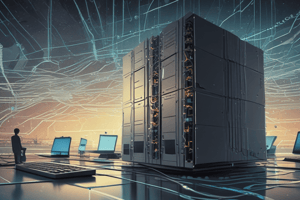Podcast
Questions and Answers
What is the name for a computer that provides information to end devices?
What is the name for a computer that provides information to end devices?
Server
What are three examples of intermediary network devices?
What are three examples of intermediary network devices?
Switches, Wireless Access Points, Routers.
Which of the following is NOT a type of network media?
Which of the following is NOT a type of network media?
- Metal
- Wireless
- Quantum (correct)
- Fiber-optic
A LAN typically spans a larger geographical area than a WAN.
A LAN typically spans a larger geographical area than a WAN.
What organization develops standards for the electronics industry and computers?
What organization develops standards for the electronics industry and computers?
Which IEEE standard is used for 10 Gigabit Ethernet?
Which IEEE standard is used for 10 Gigabit Ethernet?
The IEEE 802.11 standard is used for wired LANs.
The IEEE 802.11 standard is used for wired LANs.
What are the two primary frequency bands used by WLAN networks?
What are the two primary frequency bands used by WLAN networks?
What does MIMO technology stand for in 802.11n and 802.11ac WLAN standards?
What does MIMO technology stand for in 802.11n and 802.11ac WLAN standards?
Flashcards
Host
Host
A computer on a network, either a client or server.
Server
Server
A computer that provides information to other devices (clients).
Client
Client
A computer that requests information from a server.
End Device
End Device
Signup and view all the flashcards
Intermediary Device
Intermediary Device
Signup and view all the flashcards
LAN
LAN
Signup and view all the flashcards
WAN
WAN
Signup and view all the flashcards
Network Media
Network Media
Signup and view all the flashcards
IEEE 802.11
IEEE 802.11
Signup and view all the flashcards
Ethernet
Ethernet
Signup and view all the flashcards
Data Link Frame
Data Link Frame
Signup and view all the flashcards
Frame Header
Frame Header
Signup and view all the flashcards
Frame Trailer
Frame Trailer
Signup and view all the flashcards
MAC Address
MAC Address
Signup and view all the flashcards
IEEE
IEEE
Signup and view all the flashcards
802.11 WLAN standards
802.11 WLAN standards
Signup and view all the flashcards
Wireless LAN (WLAN)
Wireless LAN (WLAN)
Signup and view all the flashcards
Wireless Personal Area Network (WPAN)
Wireless Personal Area Network (WPAN)
Signup and view all the flashcards
Wireless MAN
Wireless MAN
Signup and view all the flashcards
Radio Frequencies
Radio Frequencies
Signup and view all the flashcards
Study Notes
CSC 2773 LAN Technologies
- Course covers LAN technologies, IEEE LAN standards, and IEEE 802.11 wireless standards.
Network Components
- Every computer on a network is a host or end device.
- Servers provide information to end devices (e.g., email servers, web servers, file servers).
- Clients request information from servers (e.g., web pages, emails).
Host Roles
- Computers on a network are either servers or clients.
- Servers provide data and services to clients.
- Clients request data and services from servers.
End Devices
- An end device is where a message originates or is received.
- Data flows through the network from one end device to another.
Intermediary Network Devices
- Intermediary devices connect end devices (e.g., switches, wireless access points, routers, firewalls).
- Manage data flow, regenerate signals, maintain network paths, and notify devices of errors or communication failures.
Network Media
- Communication across a network happens through a medium.
- Metal wires (cables) use electrical impulses.
- Fiber optic cables use pulses of light.
- Wireless transmission uses electromagnetic waves.
LANs and WANs
- LANs cover a small geographical area, are typically managed by a single organization or individual, and provide high-speed internal bandwidth.
- WANs connect LANs across wide geographical areas, are managed by one or more service providers, and typically offer slower speeds between LANs.
- Network infrastructures vary in size, number of users, services available, and area of responsibility.
The Internet
- The internet is a worldwide collection of interconnected LANs and WANs.
- Data travels through various LANs and WANs using copper wires, fiber optic cables, and wireless transmissions.
- The internet isn't owned by a single entity but is maintained by organizations like IETF, ICANN, and JAB.
LAN Topologies
- End devices are often connected using a star or extended star topology, which are scalable, easy to install, and troubleshoot.
- Other topologies include bus and ring topologies.
- In a bus topology, all devices are connected and terminate along a single cable.
- In a ring topology, each end device connects only to its neighboring devices to form a circle.
Data Link Frame
- Data is encapsulated into frames, with a header and trailer.
- The frame has three parts: header, data, and trailer.
- The header and trailer fields vary in accordance with the data link protocol.
- The amount of control information in the frame differs based on access control information and topology.
Frame Fields
- Frame start/stop identifies beginning and end of frame data, addressing indicates source and destination devices, Type identifies the Layer 3 protocol being encapsulated, Control indicates flow control services, and Data contains the actual data to be transmitted.
- Error detection fields are used in frame analysis to determine transmission errors.
Layer 2 Addresses
- Layer 2 addresses (physical addresses) are contained within the frame header.
- These addresses are used for local delivery of frames on a network.
- Each device on the network updates and forwards these addresses as needed.
LAN and WAN Frames
- The data link protocol used depends upon logical topology and physical media (e.g., Ethernet, 802.11 Wireless, Point-to-Point, HDLC, and Frame Relay).
- Each protocol manages media access within their respective logical topologies.
IEEE Standards
- IEEE (Institute of Electrical and Electronics Engineers) develops standards for electronics and computing, including network protocols.
- Its aim is fostering technological innovation for human advancement.
IEEE 802 Standards
- IEEE 802 standards define data-link layer and physical-layer technologies like Ethernet and wireless communication
- Dividing data link layer into LLC (Logical Link Control) and MAC (Media Access Control)
- Standards ensure communication between various devices and maintain network connectivity and management structure.
- 802.11 : Wireless standards (e.g., 802.11b, 802.11g, 802.11n, etc.). These standards establish radio frequencies and corresponding data rates for wireless LAN communications.
IEEE 802.3 Standards
- 802.3 Standards are Ethernet standards for wired networks.
- These standards (e.g., 10BASE-T, 100BASE-T, 1000BASE-X, 10GBASE-X, etc.) cover different speeds and cabling variations.
Wireless LAN (WLAN)
- Wireless LAN (WLAN) is used in homes, offices, and campus environments for mobility.
- Various types of wireless networks exist (e.g., WPAN, WLAN, WMAN, WWAN).
Wireless Technologies
- Wireless technologies like Bluetooth, WiMAX, and cellular broadband (using GSM and CDMA) transmit data over radio frequencies.
Radio Frequencies
The frequencies used for wireless communications in networks are detailed, including 2.4 GHz (UHF) and 5 GHz (SHF). Specific IEEE 802.11 standards operate within these bands, with particular standards supporting varied data rates and frequencies.
Studying That Suits You
Use AI to generate personalized quizzes and flashcards to suit your learning preferences.




